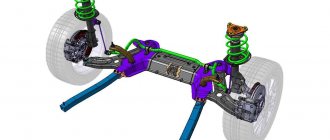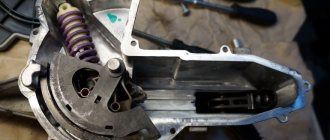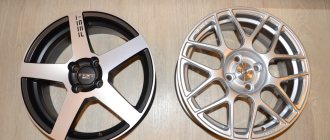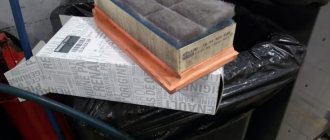Today it demonstrates enviable progress, delighting its fans with new and promising models that can successfully compete with foreign cars. A striking new product that has been seriously talked about in the global automotive arena is the Lada Vesta. Only the best constructive ideas and solutions that can be found today among foreign manufacturers are reflected in this “Russian”.
Probably, many will be interested: where is the Lada Vesta car assembled? In what city? Therefore, today we will talk specifically about this topic.
Start of production of Lada Vesta
September 2015. A model still unknown to the general public, the Lada Vesta, is launched into production. After a couple of months on the assembly line, the first copies appear on sale. Experts are very skeptical about the start of implementation, predicting the Lada Vesta will be the same failure as its predecessors.
However, over time the picture became completely different. Lada Vesta began to be bought up in large quantities, which became a reason to compare it with the best foreign cars on the market in the budget niche.
How did the manufacturer manage to succeed so much? It's simple: thanks to high consumer qualities, including:
- affordability;
- ergonomic and cozy interior;
- competitive and attractive exterior;
- capacity;
- the presence of modern assistant systems (ESP, ABS, etc.);
- fairly high degree of safety (2 airbags).
Where is the people's car assembled? Novaya Vesta is produced in Izhevsk. It also produces the Granta in the liftback version. The production of the new model was not without the participation of Renault engineers. They assisted in the design of the body, which was recreated using modern software. As a result of this interaction, Vesta’s body frame is not inferior in strength to the famous Ford Focus. The first crash tests have already confirmed this fact. In what city is the popular car in Russia still assembled?
History of the car plant in Izhevsk
A little about the plant: since 1965, they produced Moskvich, Izh-Oda, VAZ classics, heels, then Kia, which will be discussed in a separate article, because I managed to visit the museum of the enterprise.
After the 2008 crisis, things went really badly - the company laid off employees, there was no work, and bankruptcy took place. In 2010, there was a plan to start producing Koreans again, but there was a sleight of hand and the enterprise was bought by AvtoVAZ, albeit with money from the federal budget (that is, ours), as a result, production was modernized with this money, the production of Grants began, this happened until 2021 year, when the plant refocused on producing Vesta.
At the moment, only Vestas are produced at this plant; 107,000 of them are assembled per year, which is not so little. But, of course, before Soviet times the numbers didn’t even come close. Well, despite the cheerful figures in the statistics - they say the production and sales of West are growing, revenue is growing, the share of Lada is growing, everything is not so simple, the fact is that with revenue growth, production costs are growing much faster (and there will also be a separate article about this ), this is due to the fact that many spare parts are imported, and the ruble, as you know, is falling and falling, in addition, this is due to the huge general inefficiency of the enterprise, a large amount of manual labor.
As a result, for 2021, the losses of Lada Izhevsk almost reached a billion rubles; in 18-19, apparently (no data yet), it will be at the level of one and a half billion. Accounts payable - 8.5 billion, at the end of the year will be at the level of 10 billion, accounts receivable - almost 7 billion rubles. That is, at the moment there are many times more debts than assets. All this data is publicly available in the quarterly reports of both AvtoVAZ and Lada Izhevsk, you can check it.
In principle, in a competitive economy this means only one thing - bankruptcy of the enterprise and its closure. But.. we live in an amazing country, therefore, with the help of injecting our money into the economy of a Japanese-French enterprise (who doesn’t know, AvtoVAZ, which owns the Lada Izhevsk, itself belongs to the Renault-Nissan-Mitsubihsi alliance and is a foreign company that owns in our country there is only an assembly plant) the enterprise exists and in such conditions is trying to develop, which, in principle, turns out: there is growth, but losses are still growing...
Assembly and painting of a domestic model
Where is the car assembled and finalized? Welding of the main body elements is carried out using advanced robotic equipment. Although this process minimizes the influence of the human factor, it could not be done without the presence of qualified assemblers. Each stage of the assembly line takes place with the participation of workers. They hang the body panels, attach the remaining frame elements, which are subsequently welded using robotic technology.
Previously, the quality of painting of domestic bodies caused a lot of indignation among buyers. Today the situation is different. For painting Lada Vesta Cross purchases materials from global manufacturers - leaders in this market segment. Technological methods of painting, drying, polishing and other processes are constantly being improved.
The welded body is initially dipped into a special tank filled with an anti-corrosion solution. Then comes the stage of treatment with catapharesis primer. A significant proportion of these manipulations are performed by automation, but qualified painters perform their work in those places where clumsy robotics cannot get close.
Removing the Kalina torpedo
The fuel pump does not work on Kalina
Speed sensor Kalina 8 valves
Vesta SW Cross with Japanese CVT
Jatco JF015E - these “boxes” are brought to the Russian car plant in Izhevsk from South Korea, and the increase in cost for modifications with a CVT is 50 thousand rubles.
For the first time, such a transmission began to be installed on the LADA X-RAY Cross, and then on the Vesta SV Cross - with the same 113-horsepower engine, which, as is known, in tandem with the same variator is successfully used on many models, including Capture, Logan and Duster.
According to reviews, this “box” is more suitable for measured driving in city mode and is designed for buyers who do not plan to “knead the dirt” and test the off-road qualities of their “cross-station wagon”.
The final stage for Vesta
- At all stages of the production cycle, continuous supervision is carried out by engineering and technical personnel. The quality of a particular operation is checked.
- The developers took quite a lot of care about the level of equipment and the quality of the interior. Here you can see soundproofing and anti-vibration materials, which are present not only on the panels, but also applied to the bottom.
- The final stage of the assembly cycle of the Lada Vesta Cross today is little different from a similar process among foreign automakers. Upon completion of the painting work, the doors are dismantled again and sent to a special workshop, where they are finalized to a finished state.
- After installing the headlights, bumpers and other components, the body is mated to the suspension, powertrain and transmission line. Note that, in part, domestic developers use the foreign experience of world leaders in the auto industry.
- Today, the manufacturer does not intend to stop there and promises to expand the line with the introduction of a hatchback and a station wagon, in the same place where sedans are already produced.
Body, chassis, steering rack
Lada Vesta is made on the basis of a body with a subframe. This element, being part of the suspension, holds the engine on itself. Such solutions have not been used in production Ladas before.
Vesta subframe - front suspension element
Many new solutions can be found in the LADA B platform:
- The steering rack is now connected to an L-shaped arm, rather than to a protrusion at the base of the shock absorber (as it was before); Sedan front suspension
- The stabilizer was also improved: VAZ switched to using “long” struts;
- The rear suspension was copied from the Renault Megane, as was the steering rack.
Vesta’s body structure is a LADA C project. It was about a C-class sedan, which was being prepared for release in 2020.
LADA C, sedan, 2021
Unfortunately, the project did not go into series. But the developments were not in vain: some elements were strengthened, others, on the contrary, were lightened or removed. This is how the Vesta sedan body appeared.
Still, let’s answer the question on what basis the Lada Vesta is made:
- The body is a LADA C project, but with modifications;
- Rear suspension – Renault Megane;
- Front suspension - all components were developed from scratch;
- The design uses solutions that have never been used before: subframe, L-shaped arms, etc.
And now - some photos.
Front suspension (struts and arms) Rear suspension (elastic beam)
Let's sum it up
Many will ask: does the Lada Vesta Cross plan to be assembled somewhere other than Izhevsk? Yes! Assembly production at ChechenAvto is being established. The company is located in Argun. Also, Kazakh colleagues will soon begin cooperation with Tolyatti residents, since assembly will soon begin in Ust-Kamenogorsk at the facilities of BipekAvto, where other cars are also produced. Now you have become familiar with where Vesta is collected.
So, according to experts, today’s strategy of the Russian auto giant is correct, and it is not known in what city the model will be assembled in the future!
What does the lada b platform consist of?
The reader might have guessed that the LADA B platform became the basis of the Vesta model. And this platform has absorbed the features of three different projects: LADA C, “Project 2180”, “restyling Lada Priora”.
LADA 2180, test drive
One gearbox and one engine are borrowed from the “alliance”: we are talking about the “JHQ mechanics”, as well as the “HR16DE” engine. These two knots went well with each other, but not with anything else. But VAZ engines are equipped with both Russian and French gearboxes. Here we are talking about engines 21129 (1.6) and 21179 (1.8).
As for engines, engine 21179 was created for the LADA C sedan. It migrated to the X-Ray (B0) crossovers, but compatibility with the LADA B platform has not been canceled either.
Characteristics of internal combustion engines 21179 and 21129
Number of cars produced
Since the official start of sales of the Lada Vesta station wagon, the plant has not had time to assemble the necessary configurations, and the stocks of ready-made Vestas in dealer warehouses very quickly ran out. Sometimes the queue of clients reached more than 3 months, and dealers, as always, tried to sell happy customers as much additional equipment and services as possible (some, without a hint of embarrassment, refused to give the already pre-paid copy to the owner if he did not follow the seller’s lead.) Now it’s the turn. has decreased, sales of the Lada Vesta of all modifications are growing. Since the onset of 2018, 24,300 copies have been sold, more than half the result of the same period last year.
Statistics of cars sold
The new model called “Vesta” has appealed to many car enthusiasts, as evidenced by statistics. Growing sales compared to 2017 only give VAZ management confidence, which is why they are trying to enter the European market. Until the end of April, “Vestas” will be available in station wagon body and “Comfort” equipment options with 1.6 liter engines. environmental class Euro 6 and any type of gearbox must reach car dealerships with a starting price of no more than 12,000 Euro. AvtoVAZ hopes for sales growth in Europe, because over the past year, 909 sold cars found their owners there.
Stamping
In 2015, the workshop was significantly modernized for its own production under the supervision of Japanese specialists. In 2021, for the production of LADA Vesta SW and LADA Vesta SW Cross, stamping of 79 new and modified body parts was mastered. There is a special control table for each of them. Two years ago, a new XL press line went into operation (four presses with a total force of 5,400 tons) for large stampings (sidewalls, doors, wings, etc.).
The main differences between the cross version and the station wagon
How strong are they, and how did all this affect the rise in prices of domestic automotive products? Let's figure it out together
The all-terrain vesta has only 1 trim level called “Luxe”:
- increased by 2 and a half cm (203 vs 178 for a simple SV station wagon);
- slightly different interior design;
- a branded color exclusive to the cross version called “Mars” is available;
- 4 airbags (2 front and a similar number of side);
- A plastic anti-scratch body kit is installed on the arches and sills;
- 17-inch;
- driver assistants - ABS, ESP systems with anti-slip function;
- steering column with steering wheel adjustment in 2 planes (up/down, forward/away);
- heated front seats;
- driver's seat height adjustment;
- heated exterior mirrors with electric adjustment;
- heated windshield;
- climate control system and maintaining the designated speed;
- not a bad system with very decent sound;
- parking sensors;
- cooled glove compartment and other necessary things.
It is also possible to order additional option packages that add:
- heated rear passenger seats;
- rear sofa with armrest;
- interior lighting LEDs;
- radio with the ability to use a navigator; factory tinted rear windows;
- rear view camera.
The increase in price of the Vesta SW Cross compared to the “landed” “car” can be simultaneously called significant and also small: the maximum configuration of the Cross Vesta with a 1.6 engine on a manual gearbox will be about 780 thousand Russian currency. For the installation of a larger power unit, you need to pay an additional 25 thousand rubles and 25,000 for a robotic box developed by specialists from the Volzhsky Automobile Plant. The body paint is available in 9 color options, for metallic you need to pay an additional payment of 12 thousand. Do you want an exclusive color? Pay only 18 thousand extra and you will be the owner of a color with the interesting name “Carthage” (beige metallic).
Welding
This workshop also received a new birth with the arrival of LADA Granta production and additional modernization with the production of LADA Vesta. Parts of future machines travel along a one-kilometer transport line. Real, live welders are assisted by robotic welders - for example, 36 automatic line robots are used to weld the chassis and body.
In order to see what is happening in this workshop without harm to health, special glasses are issued. Very stylish. The welded elements are run through a 3D control and measurement laboratory. Thousand-watt lamps reveal even the smallest defects, which are immediately corrected, if any.
The skeleton of the future car, moving along the conveyor, acquires wings, doors, trunk lid and hood, passes the next control point, and then is sent for painting.
AvtoVAZ conveyor
By the way, almost all the equipment, machines, presses are all imported. As you know, our country, at the moment, is not capable of producing high-quality machines for such an industry, from domestic ones, from what I saw, only tables, carts, all sorts of small things.
On the one hand, of course, this is sad, because before it was all domestic, but on the other hand, at the moment, this is the only way to ensure at least some acceptable quality of parts, however, in my opinion, the point is not so much in them as in attitude towards work, quality control.
So, for example, the kaizen system was taken from Japanese factories, and so it’s not even a system, but a whole philosophy, it lies in the continuous improvement of production processes, development, auxiliary business processes and management, as well as all aspects of life, respectful attitude towards the client - main postulate. It’s very cool to change not just production processes, but the entire philosophy of both the plant itself and the people working at it. I don’t know how successfully this was implemented at this plant, but it’s a cool thing, Toyota was the first to introduce it, and such borrowing is very commendable.
By the way, for those who are interested in this philosophy and how to apply it in life and business, I highly recommend reading Masaaki Imai’s books “Kaizen: the key to Japanese success.” At the very least, it will be useful for general development, and if you work in an enterprise or have your own business, it will be very relevant!
It’s unlikely that the workers at VAZ read them, but the topic is suitable for personal efficiency and the efficiency of business processes. Nevertheless, brief theses and partial pieces from there are visible at the plant - in the form of slogans, posters, and stands.
In general, the conditions and attitude of the employees, of course, changed and clearly for the better - correct communications, open participation of the same employees, it was easy to come up and ask some questions, they were answered, to the extent possible. I was even able to immediately stumble upon the person I needed, but more on that later.
Many little things make up the production culture, for example, labor protection and human health. The next workshop was the welding shop, and at its entrance, right after the warehouses with body parts, there were boxes and tables with glasses to protect the eyes - really well done. Nothing like this happened last time. And glasses were really needed - the corridor with visitors is located in close proximity to the conveyor itself and sparks and scale from welding fly in all directions, for example, onto the fur coat of a glamorous woman standing next to her, but nothing, they were extinguished))
One of the most important operations for maintaining accuracy, and subsequently the rigidity of the body, is the assembly of the car body itself: these are the side panels, the engine shield, the rear panel, the floor and the roof. Almost everything depends on how this is done.
AvtoVAZ spoke about the Lada Izhevsk plant, where the Lada Vesta is produced
The next issue of the video magazine “Okay Mechanics” has been released.
This time the presenters (Yanina Pavlova and Stanislav Bereziy) talked about the LADA Izhevsk plant (part of the AVTOVAZ Group), where all modifications of the Lada Vesta are currently produced. The Lada Izhevsk plant has a full production cycle technology: stamping, plastic injection, welding, painting and assembly. The production capacity of the car plant is 30 cars per hour. Last year, 20 Lada Vesta and 10 Lada Granta cars were produced here per hour. After the transfer of production of Lada Granta lift kits to Tolyatti, all capacities of the Izhevsk Automobile Plant were allocated to Lada Vesta.











